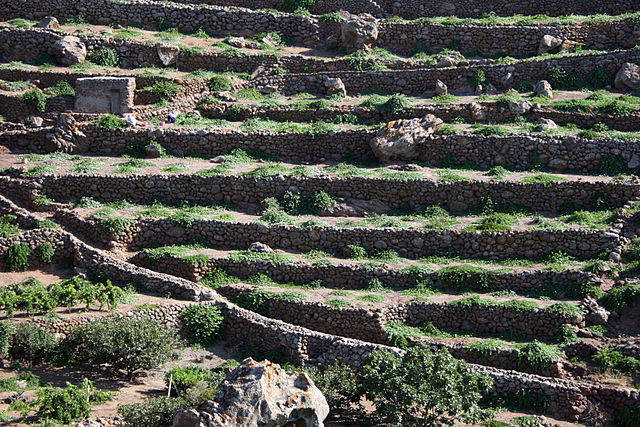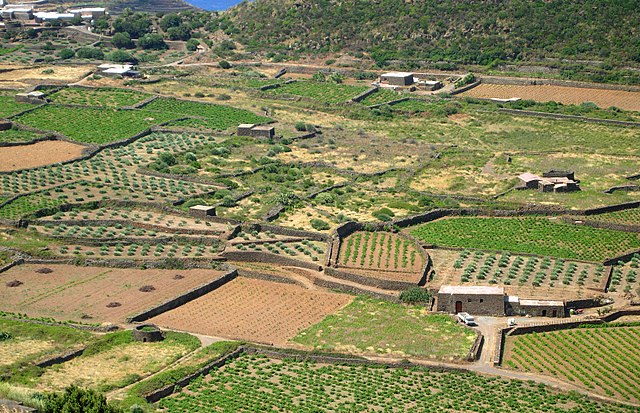Traditional agricultural practice of cultivating the ‘vite ad alberello’ (head-trained bush vines) of the community of Pantelleria
Introduced by the Phoenicians, the head-trained bush vines of Pantelleria (“vite ad alberello”) is a type of grape cultivation. Perfected and handed down over the centuries thanks to the wisdom and dedication of the farmers of Pantelleria. Capable of obtaining that exceptional grape that is the “Zibibbo”. Even in the presence of really extreme conditions. Zibibbo is the grape of Passito di Pantelleria, a sweet wine unique for its organoleptic characteristics. A precious wine that allows you to repay the effort and costs (3 times those of a vineyard in Sicily) of this viticulture that is typical of Pantelleria.

The cultivation of vines on the island of Pantelleria has shaped the Sicilian landscape over time. Creating one of the most evocative agricultural contexts in the world. The protagonist of such beauty is the particular system of cultivation of the vine, the head-trained bush vines. It is a form of cultivation studied and admired all over the world. Because, following nature, has been able to achieve a viticulture excellence.
The ancient tradition
The “vite ad alberello” of Pantelleria is an agricultural practice that represents an example of unique vine cultivation. Handed down from generation to generation by the island’s community. The head-trained bush vines are low and sheltered by a hole in the ground. And also by dry stone walls, made with small stones. Which protect the plants from the wind and adverse weather conditions. That characterize the island of Pantelleria for ten months a year. Thus guaranteeing the production of grapes and the life of the plant itself.
The island of Pantelleria is in fact characterized by a constant windiness. By a scarce rainfall compensated by a high humidity. Due to its impervious terrain on which man created masterful terraces. On the terraces, often with extreme slopes, the vines grow below ground level. In a large hole, to shelter the plant from the winds that blow, often violently, on the Island.
vite ad alberello of Pantelleria at Summer

In Pantelleria we talk about heroic viticulture. The processes, in fact, require many hours of work throughout the year. Which at least three times exceed those necessary for the cultivation of a normal vineyard in Sicily. This greater work is necessary to counteract the disadvantages of the Island. Such as the particular climatic conditions. The whipping wind all year round, the absence of fresh water sources, the low rainfall. And also the steeply sloping land. Because there are no machines that can replace the farmer, the vineyard in Pantelleria can only count on the arms of man.
A sustainable practice because it is almost exclusively manual. As it could not be otherwise to cultivate the head-trained bush vines among the terraces of the island. Small patches of land torn from the mountain and supported by dry lava stone walls that paint the landscape. And defend it also from erosion.
A heroic viticulture that survives above all thanks to the work of passionate producers of the island’s symbolic wine: Passito di Pantelleria. An unique sweet natural wine, of extraordinary richness and aromatic complexity.

The cultivation technique involves several phases and ends with the hand-made harvest. During a ritual event that begins at the end of July. The rituals and celebrations, which continue until September, allow the local community to share this social practice. Which identifies the inhabitants of Pantelleria as expert winemakers. Encouraging them to commit themselves more and more to preserving this traditional and unique practice.
Terraces and dry stone walls
The “vite ad alberello” of of Pantelleria is also a creative and sustainable agricultural practice. And therefore worthy of protection and handed down. Creative because it is founded on the hole dug in the ground to accommodate the vine. Protect it from the wind, nourish it with the humidity of the night that collects and does not disperse. Creative because the pruning system makes the plant develop with a horizontal and almost creeping trend on the ground. And therefore able to survive the constant wind that blows on the island. Sustainable because its cultivation is entirely manual.

The terraces are the landscape designed by man in Pantelleria to grow sapling vines, the result of indigenous rural ingenuity. The terraces supported by dry stone walls outline the landscape of Pantelleria and defend it from erosion.
The cultivation of head-trained bush vines is based on ancient techniques. Holes about 20 centimeters deep, called “conche”, are dug in the ground. Where the vineyard takes the form of small saplings. This ingenious procedure allows to make the most of the little water present in the soil. And at the same time protects the small vineyards from the wind. The grapes obtained from these vineyards are the raw material for the vinification of the sweet Pantelleria wine.

The Zibibbo grape
The zibíbbo grape is the main cultivar of the island, known for the aromatic richness that is given to it by maturing under the sun of Pantelleria and by the rich volcanic soil.
It is thought that the name of the grape is associated with Cape Zebib, in present-day Tunisia. Which reinforces the thesis of the original import from North Africa.
For centuries the island’s farmers cultivated Zibibbo vine. First for local use. Then transforming itself into one of the most important economic and valuable activities of Pantelleria starting from the last century.
Today the Pantelleria tradition derives the Moscato DOC di Pantelleria from Zibibbo, produced in numerous wineries on the island. The procedure that gives life to Moscato is subject to a strict disciplinary that protects its ancient tradition.
After harvesting and pressing, the must is macerated on the skins to absorb all the aromas of the Pantelleria land. And then fermented. The most famous version is the Passito di Pantelleria. So called because the Zibibbo grapes are dried directly on the plant or on racks after harvesting. The alcohol content must not be less than 20%. While the Passito in the liqueur version must reach at least 22%.
Characteristics of the “vite ad alberello” of Pantelleria
In Pantelleria farmer continue to use the same ancient technique. This form of cultivation, which requires constant care, a lot of patience and physical effort, helps to create the identity of a community that has followed its traditions for centuries.

The sapling is a form of vine cultivation with very ancient origins and strongly associated with the viticultural tradition of the Mediterranean regions.
The technique is particularly suitable for small vineyards, characterized by conditions of limited water availability or an unfavourable climate.
Vines are placed in holes in the ground, below the ground level. To protect the plant and the fruit from the sirocco and Greek east winds.
The plants take the form of small saplings, in order to steal the scarce water resources present in the soil. And to shelter from the unfavourable climate. The sapling is generally characterized by a limited development both in height and in volume. For this reason it is suitable for small areas. In fact, the head-trained bush vines technique limits the development of the stem. And instead favours the growth of the roots. The head-trained bush vines are therefore on a human scale. In such a way as to manually intervene on the vines.

The “vite ad alberello” of Pantelleria as Intangible Cultural Heritage of Humanity
The Intangible Cultural Heritage of Humanity includes practices, representations, knowledge and know-how. That deserve to be safeguarded and promoted, as vital components of traditional cultures. There are five “categories”: oral expressions (including language as a vehicle of the intangible heritage); the performing arts; social customs, ritual and festive events; knowledge and practices relating to nature and the universe and, finally, the knowledge and practices related to traditional craftsmanship.
UNESCO inscribed the Traditional agricultural practice of cultivating the “vite ad alberello” of the community of Pantelleria on the Representative List of the Intangible Cultural Heritage of Humanity in 2014. A wonderful recognition for its value and its significance. The entry of the head-trained bush vines of Pantelleria in the World Heritage list is, for the world of quality wine, a tribute to Zibibbo. And to the vine cultivated with so much love and so much effort. But above all to the flagship product of the island of sun and wind: the Passito di Pantelleria. Always a symbol of a community, the head-trained bush vines of Pantelleria is now a World Cultural Heritage.
“vite ad alberello” of Pantelleria near shore
It was the first time that UNESCO attributes this recognition to an agricultural practice. Recognizing its historical and cultural value as well as its identity. Furthermore, this cultivation also has a significant economic function. Since the grapes obtained from these vineyards are the raw material for the vinification of the precious Zibibbo of Pantelleria. And fulfils an important social function, being an identity element that represents the culture and history of the islanders.
Furthermore, from the beginning of the seventies to the beginning of the eighties of the last century, there has been a significant reduction in the areas planted with the head-trained bush vines. In favour of cultivations that can offer higher yields and integrate better with mechanization. This makes UNESCO recognition even more important, as it supports those who continue to protect and safeguard this ancient technique.
Resume
The head-trained bush vines of the island of Pantelleria is an ancient and traditional form of vine cultivation. Typical of the small vineyards of Pantelleria, in Sicily, of the white grape variety “Zibibbo”. A type of cultivation, introduced by the Phoenicians, perfected and handed down over the centuries, capable of producing splendid fruits in extreme conditions. The head-trained bush vines of Pantelleria, due to its characteristics, is considered a cultivation model to be safeguarded, promoted and studied. In 2014, UNESCO declared the “Agricultural practice of growing head-trained bush vines, typical of the island of Pantelleria”, an intangible cultural heritage of humanity. UNESCO has in fact recognized the historical-cultural and identity value of this unique cultivation in the world. Which over time has shaped the landscape of the Island.

